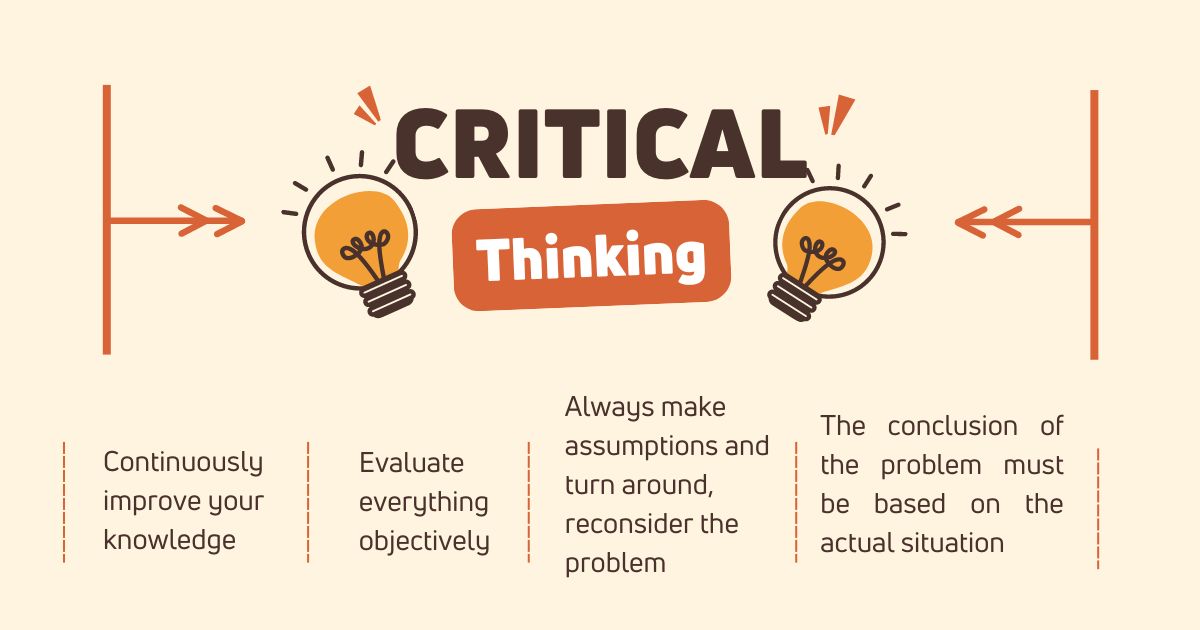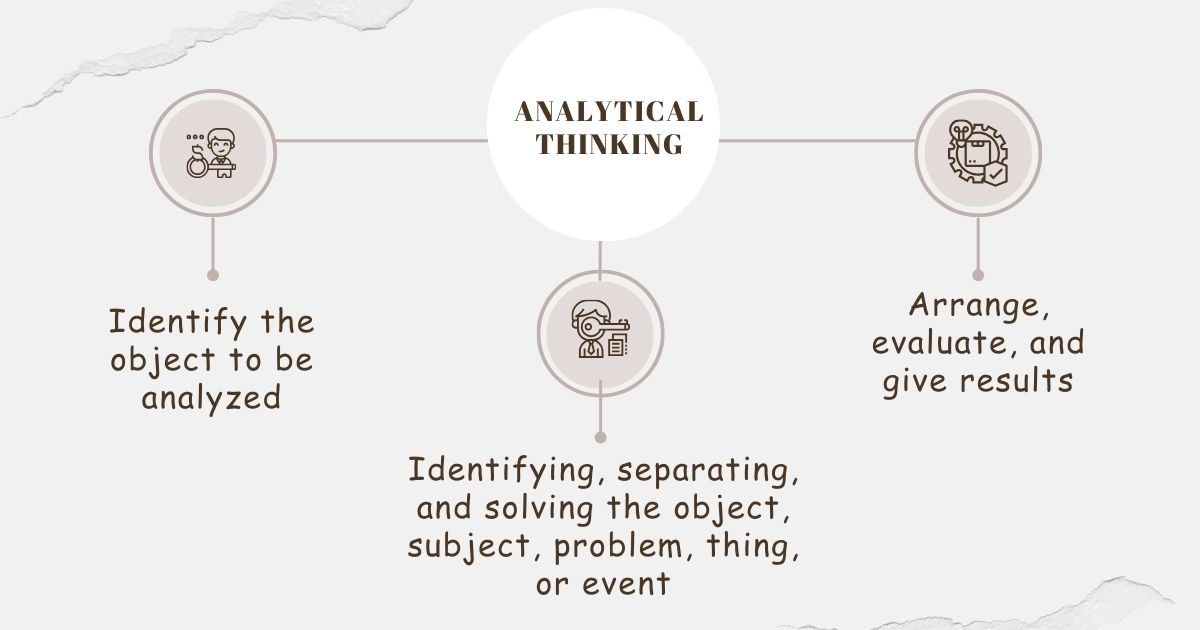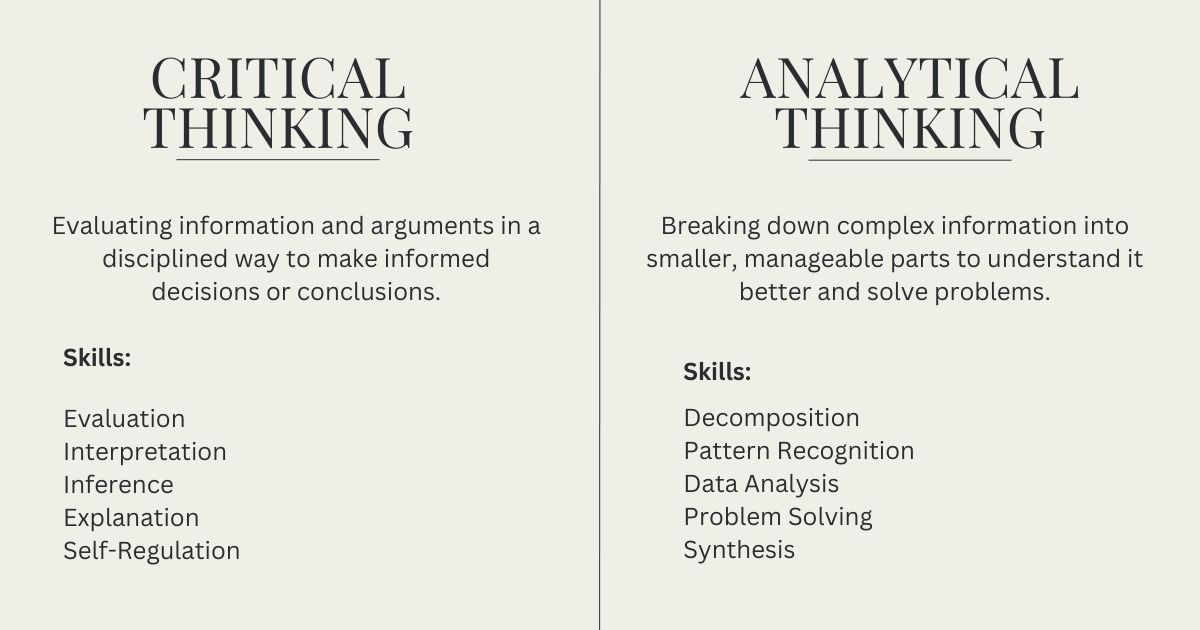Critical Thinking vs Analytical Thinking: What's the Difference?
Thinking is a daily human activity, a field that attracts a lot of attention and research from many scientific fields in the world today. Do you know critical thinking and analytical thinking are often used interchangeably, but they represent distinct cognitive processes? While both are essential for effective problem-solving, they serve different purposes. Let's explore the nuances between these two mental abilities.
What is Critical Thinking?

Critical Thinking is the process of analyzing, evaluating, and questioning hypotheses or assumptions, then forming a way of thinking and expressing opinions when faced with a certain problem. In other words, critical thinking is the skill to express views on a problem, proving that an opinion is correct, reasonable, consistent, and logical. At the same time, refuted opinions are contrary to the above opinion.
Types of critical thinking
Critical thinking can be divided into two types
Self-regulating critical thinking
When faced with a problem, each person will have subjective opinions. Those opinions may be right or wrong. However, to evaluate that, it is necessary to have self-regulating critical thinking. It is the process in which each person debates his or her own opinions. We will evaluate and refute the subjective things in our initial thinking. Improve ourselves to give the most complete rebuttal content.
External critical thinking
In a community, each individual will have different ways of thinking and reasoning. From there, viewpoints will also deviate and even swerve from the truth. External critical thinking is formed to solve this problem. It is carried out in 3 steps:
1. Awareness: Recognize the problem with its differences, and simultaneously recognize the overall opinions of others.
2. Evaluation: After clearly recognizing the things in the rebuttal opinions of others and yourself, you will give the most objective assessments.
3. Refute the problem: From your assessments and viewpoints, refute incorrect opinions, then provide correct information.
Training Critical Thinking Method
Developing this skill requires deliberate practice and a structured approach. Here’s a methodical approach to training critical thinking:
Continuously improve your knowledge
A misconception that many people have. That is, a person with good critical thinking is a good speaker. Skilltrans wants to emphasize that, in this skill, the first thing mentioned, and the most important thing, is Thinking. Before speaking out and arguing about an issue, it is necessary to understand that issue clearly to have the most objective and general view. So, the first thing to do is to study, constantly improve your knowledge, read books, and practice the ability to observe.
A person with extensive knowledge and understanding of the issue will have the skill of confidence. On the contrary, if you lack basic or general knowledge of the problem. Critical thinking will encounter many difficulties. You may even reach a dead end and evenly be forced to stop.
Evaluate everything objectively
One of the biggest barriers to critical thinking is subjective thinking. When problems are solved emotionally and too much ego is put into it, the problem will not be analyzed or solved thoroughly. Therefore, instead of thinking about everything in a personal way, let's eliminate the subjective perspective and be objective in everything. From there, the problem will be considered logically, limiting barriers to criticism.
Always make assumptions and turn around, reconsider the problem
To think critically most clearly, asking hypothetical questions and turning around the problem is indispensable. When approaching a problem or new information, you should always ask questions. The hypothetical questions asked can be related to the problem, so the topic raised will be a deeper, more detailed understanding.
The hypothetical question can be related to your assessment. You can make assumptions about the rightness or wrongness of the problem and ask more questions to improve your thinking.
After having hypothetical questions and making your assessments. Let's take the problem back and look at it again. Look at it from the opposite perspective you may find more new ideas. You even discover loopholes in previous thoughts or arguments.
The conclusion of the problem must be based on the actual situation
In the process of critical thinking, you may encounter many opposing opinions. When faced with objections, do not rush to conclude the results. Stay calm and analyze the problem again in a realistic way. Consider the right or wrong of the matter based on what has been proven before, and draw your conclusions.
Concluding the problem based on emotions is taboo. It not only makes your thinking and knowledge wrong and distorted, but it also makes you lose confidence next time.
What is Analytical Thinking?

It can be understood that analytical thinking is the process of synthesizing, dissecting, and separating data about a thing or event to understand its nature, role, and connection between them and other objects to provide solutions or demonstrate the problem that needs to be demonstrated. Analytical thinking often tends to think in depth with high gathering ability, which is evaluated through different factors that the subject uses.
If thinking is the activity of the human nervous system, reflecting their perception in a general way through the worldview and things; analysis is the activity of breaking down things and events to find the connection between them to demonstrate a problem.
In the context of modern social life, the era of technology is dominating, practicing analytical thinking will assist us perceive all problems, things, or events faster, understanding their nature better, and helping each person solve work more easily.
Analytical thinking can be applied in all situations. Analyzing a topic means that you have cultivated a deep understanding of that topic and can talk about that topic with people with higher expertise.
What are the manifestations of analytical thinking?
The process of forming analytical thinking about an object, thing, event, or problem often goes through the following main steps:
First, it is to identify the object to be analyzed. It can be an object, event, or problem.
Step two is to collect and synthesize information about the subject, thing, event, or problem. We need to collect and synthesize information related to the object, then filter valuable information and eliminate unimportant information. This step requires you to have the ability to be logical and link related information chains to find the right direction to solve the problem, bringing about work efficiency.
After collecting and synthesizing information, it is the step of identifying, separating, and solving the object, subject, problem, thing, or event. You split the information branches, analyze them according to different factors to find the true nature deep inside them, explain the meaning, and clarify the problem that needs to be proven. Note that in this step, it is necessary to apply the skill of identifying trends and causal relationships between the information collected above.
The final step is to arrange, evaluate, and give results. After analyzing and separating the objects, events, information related to the problem and the subject, we will have a conclusion about it. Evaluate its positive and negative points to come up with a suitable solution.
It can be seen that analytical thinking is one of the significant skills that helps each person easily perceive and solve problems. People with analytical thinking skills will look at things in depth with both subjective and objective aspects, thereby aiding them in quickly making correct and appropriate decisions.
At the same time, analytical thinking plays an important role in assisting each person to find solutions to problems and make the right decisions with their actions.
Understanding the problem and analyzing the situation to find feasible solutions is an important skill in every position, every level. Developing analytical thinking skills can improve our work, aiding ourselves achieve goals in life.
The downside of analytical thinking
Besides the benefits it brings, analytical thinking also has downsides that make it not as effective as expected.
When analyzing a problem or object, we have to collect and synthesize information about them. However, collecting this data is never enough with the diverse and widespread information sources today. With such an overwhelming amount of information, sometimes we will get carried away and possibly deviate from the original direction.
Not only that, when applying analytical thinking in synthesizing data to evaluate and provide solutions for a series of related problems, we often apply that solution to objects in many different situations. Without knowing that each problem, when placed in a different situation, has a different nature, the solution is naturally no longer appropriate. In addition, depending on the changes in time and space, problems and objects develop more complexly, requiring more advanced solutions instead of only applying old solutions.
In particular, analytical thinking often forces us to perceive the world from an individual's perspective, ignoring other related objects. This invisibly reduces the objectivity in the way each person evaluates things, events, objects, and problems. It only has meaning for the individual, not leaving long-term and recognized results, as well as creating separation between people.
Finally, analytical thinking often tends to make solutions based on past and present conditions, not the future. Therefore, characteristics, solutions, and directions can become outdated over time.
How to practice analytical thinking?
Like other parts of the body, analytical thinking also needs to be trained through the learning process.
One of the ways to assist you improve analytical thinking is to read books. Books are the knowledge of humanity. Reading books gives us plenty of useful information, stimulating our brains to work actively. Books with many different genres will increase information data for each person, helping us have an overview of all problems, building a ready-made information framework for analysis, and shortening the time to come up with solutions for the problem.
Similarities between Critical Thinking and Analytical Thinking
Both types of thinking need a systematic approach, logical reasoning, and attention to detail. They often overlap, as critical thinking might utilize analytical thinking to evaluate evidence, and analytical thinking might use critical thinking to assess the significance of data.
Understanding the distinction and interplay between these two types of thinking can enhance problem-solving in various contexts.
What's the Difference between Critical Thinking and Analytical Thinking?

Although often used interchangeably, critical thinking and analytical thinking are different cognitive processes.
Analytical thinking breaks down complex information into smaller, more manageable parts. It relies heavily on facts and figures to make sense of a situation. It aims to understand the components of a problem or situation without making judgments.
Critical thinking goes beyond analysis to evaluate the value and reliability of information. It challenges assumptions, as well as considers alternative perspectives. Critical thinking uses analysis and evaluation to make informed decisions.
Analytical thinking is about understanding parts of information, while critical thinking is about evaluating the whole. In short, analytical thinking is a part of critical thinking. While analytical thinking focuses on analyzing information, critical thinking goes further by evaluating, interpreting, and drawing conclusions from that information.
| Critical Thinking | Analytical Thinking | |
| Evaluating information and arguments in a disciplined way to make informed decisions or conclusions. | Breaking down complex information into smaller, manageable parts to understand it better and solve problems. | |
| Focus | Broad evaluation of information to form a judgment. | Detailed examination of components to understand and solve problems. |
| Approach | Questioning, reflecting, and evaluating. | Breaking down, analyzing, and synthesizing. |
| Skills |
|
|
| Purpose | The main goal of critical thinking is to arrive at a well-reasoned judgment or decision. | The primary aim of analytical thinking is to understand how different parts of a problem or system interrelate and to find solutions or insights through structured analysis. |
| Example | In a debate, a critical thinker assesses the strength of each argument, identifies logical fallacies, and considers different perspectives before forming an opinion. | In a business setting, an analytical thinker might analyze sales data to identify trends and make data-driven decisions to improve performance. |
Ready for more? Skilltrans introduces a lineup of courses to keep you ahead of the curve:
How To Identify Fake News and Fight Misinformation
The abundance of information makes identifying fake news and fighting misinformation, an essential skill in navigating the world we live in.
Being able to tell the fake from the real, the sensational from the relevant, and the manipulation from genuine interest, become reliable tools in our decision-making processes and ultimately, shape the way we build our own life and the society we live in.
Enroll in this course and discover new ways to optimize your critical thinking strategies and skills. Please click on the course name below to learn more:
Soft skills for life & work: develop yourself for success
This course aims to give you an insight into the essential soft skills and how you can use these, as well as to look at your own soft skills and identify the areas where you want to improve. The course will also give you a wealth of soft skills tools, tips and strategies to use for personal development and success in your life and at work.
As you go through the course you will be able to apply the learnings and develop your own personalised soft skills plan.
The course is designed to be practical and relevant to real life. It includes lots of ideas, tips and strategies, straightforward explanations and lots of information for you to use as to how to develop and improve your soft skills. It is not a theoretical or academic course on soft skills.
Disruptive thinking, User centric approach & Cognitive bias
In our course on Disruptive Thinking, User-Centric Approach, and Cognitive Bias, you'll learn how to challenge traditional norms, cultivate creativity, and overcome cognitive biases to drive meaningful change in today's dynamic landscape. Whether you're a young professional, manager, or aspiring leader, this course offers the tools and insights you need to thrive in an ever-evolving world. Don't just adapt to change—embrace it and lead the way forward. Enroll now and embark on a journey of transformation!
Conclusion
Understanding the differences between critical thinking and analytical thinking can significantly enhance our ability to navigate complex information and make sound decisions. Critical thinking evaluates information, questioning assumptions, and drawing well-reasoned conclusions. On the other hand, analytical thinking breaks down complex problems into manageable parts, identifying patterns and deriving logical solutions.
Whether in personal decisions or professional endeavors, integrating critical and analytical thinking empowers us to think more deeply, act more strategically, and achieve better outcomes. As we continue to develop these essential skills, we equip ourselves to face the challenges of an increasingly complex world with confidence.
Critical thinking and analytical thinking are two essential skills for anyone aiming for success. To practice these skills most systematically, you can register for Skilltrans courses today. Useful courses are waiting for you to learn.

Meet Hoang Duyen, an experienced SEO Specialist with a proven track record in driving organic growth and boosting online visibility. She has honed her skills in keyword research, on-page optimization, and technical SEO. Her expertise lies in crafting data-driven strategies that not only improve search engine rankings but also deliver tangible results for businesses.



